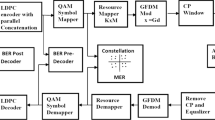Abstract
This paper presents an area-efficient 4- stream finite impulse response (FIR) interpolation/decimation for IEEE 802.11n wireless local area network (WLAN). Novelty of the presented design is threefold. First, a multi-path pipelined polyphase structure is proposed to deal with multiple data streams, thereby four simultaneous data streams can be supported in the design with minimal hardware complexity. Second, a hybrid common subexpression elimination (HCSE) method that using signed binary representation of coefficients is applied to the implementation of subfilters. The multiplications in each subfilter are efficiently implemented using a few hardwired shifts, adders, and subtracters. And last, the interpolating mode and decimating mode of the design are configurable. That help to improve system level hardware utilization efficiency since WLAN is a time division duplex system. Under 0.13 μm 1.2 V 1P6M CMOS technology, the cell area and power consumption of the presented interpolation/decimation are 0.22 mm2 and 10.08 mW respectively. The error vector magnitude (EVM) performance of an 802.11n baseband prototype which adopts the presented design is measured −42.2 dB.











Similar content being viewed by others
References
IEEE Std. 802.11n (2009). Wireless LAN medium access control (MAC) and physical layer (PHY) specifications: enhancements for higher throughput. New York, NY, USA
Perahia, E., & Stacey, R. (2008). Next generation wireless LANs: throughput, robustness, and reliability in 802.11n. New York: Cambridge University Press.
Hogenauer, E. B. (1981). An economical class of digital filters for decimation and interpolation. IEEE Transactions on Acoustics, Speech, and Signal Processing, 29(2), 155–162.
Proakis, J. G., & Manolakis, D. G. (2006). Digital signal processing: principles, algorithms, and applications. New Jersey: Prentice Hall.
Dempster, A. G., & Macleod, M. D. (1995). Use of minimum adder multiplier blocks in FIR digital filters. IEEE Transactions on Circuits and Systems. II, Analog and Digital Signal Processing, 42(9), 569–577.
Hartley, R. I. (1996). Subexpression sharing in filters using canonic signed digit multipliers. IEEE Transactions on Circuits and Systems. II, Analog and Digital Signal Processing, 43(10), 677–688.
Vinod, A. P., & Lai, E. M.-K. (2006). Low power and high-speed implementation of FIR filters for software defined radio receivers. IEEE Transactions on Wireless Communications, 5(7), 1669–1675.
Mahesh, R. A., & Vinod, P. (2008). A new common subexpression elimination algorithm for realizing low-complexity higher order digital filters. IEEE Transactions on Computer-Aided Design of Integrated Circuits and Systems, 27(2), 217–229.
Johansson, H., & Gustafsson, O. (2005). Linear-phase FIR interpolation, decimation, and Mth-band filters utilizing the farrow structure. IEEE Transactions on Circuits and Systems I, 52(10), 2197–2207.
Haene, S., Perels, D., Burg, A. (2008). A real-time 4-stream MIMO-OFDM transceiver: system design, FPGA implementation, and characterization. IEEE Journal on Selected Areas in Communications, 26(6), 877–889.
Ryan, P., Arivoli, T., Souza, L. D., etc. (2001). A Single chip PHY COFDM modem for IEEE 802.11a with integrated ADCs and DACs. In Proc. IEEE international solid-state circuits conference (ISSCC) (pp. 338–339).
Dubuc, C., Starks, D., Creasy, T., Hou, Y. (2004). A MIMO-OFDM prototype for next generation wireless WANs. IEEE Communications Magazine, 42(12), 82–87.
Perels, D., Haene, S., Luethi, P., etc. (2005). ASIC implementation of a MIMO-OFDM transceiver for 192 Mbps WLANs. In Proc. european solid-state circuits conference (ESSCIRC) (pp. 215–218).
Perels, D. (2007). Frame-based MIMO-OFDM systems: impairment estimation and compensation. Ph. D. dissertation, Federal Institute of Technology, Swiss, pp. 106–111.
Acknowledgements
This work was supported by the Major National Science and Technology Program of China under grant No. 2010ZX03005-001 and the National Natural Science Foundation of China under grant No. 60976022. The authors would like to thank X. Zhang for her help to improve the manuscript.
Author information
Authors and Affiliations
Corresponding author
Rights and permissions
About this article
Cite this article
Zhang, Zd., Wu, B., Zhu, Yx. et al. An Area-Efficient 4-Stream FIR Interpolation/Decimation for IEEE 802.11n WLAN. J Sign Process Syst 69, 115–123 (2012). https://doi.org/10.1007/s11265-011-0633-7
Received:
Revised:
Accepted:
Published:
Issue Date:
DOI: https://doi.org/10.1007/s11265-011-0633-7




